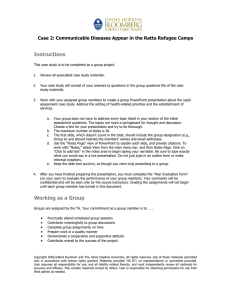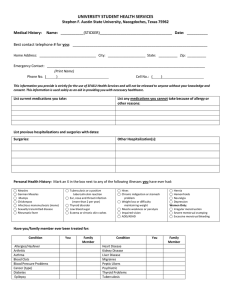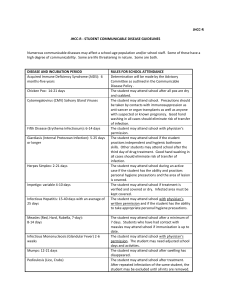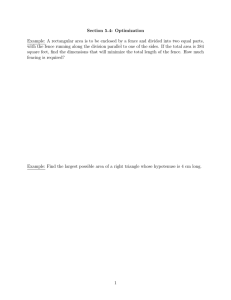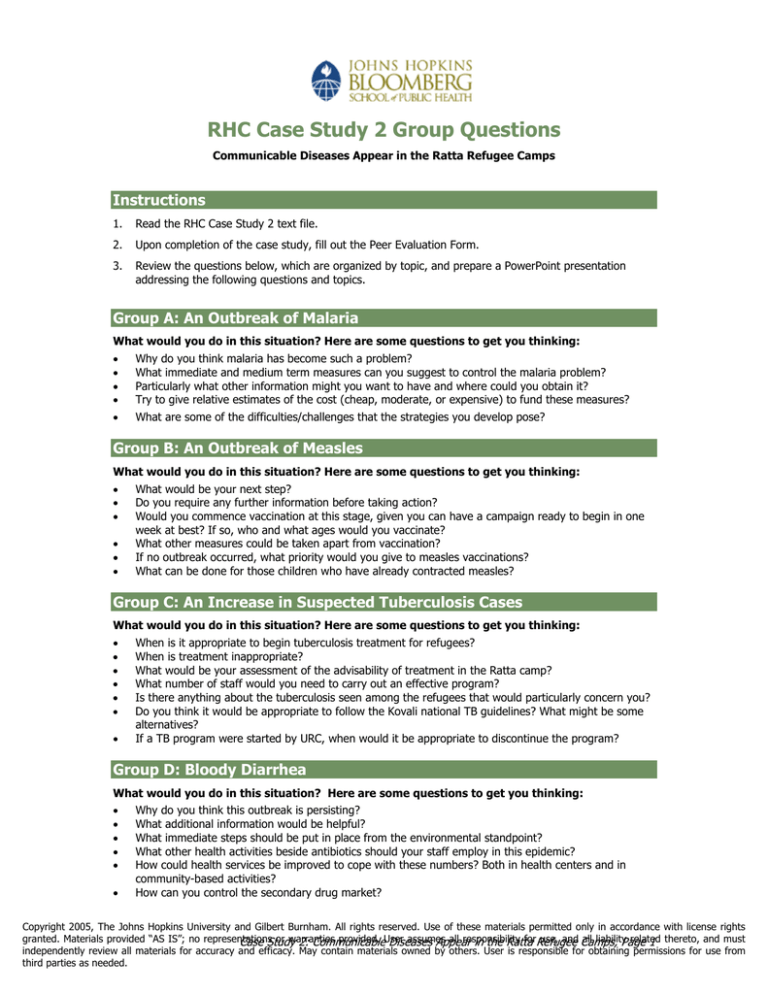
RHC Case Study 2 Group Questions
Communicable Diseases Appear in the Ratta Refugee Camps
Instructions
1.
Read the RHC Case Study 2 text file.
2.
Upon completion of the case study, fill out the Peer Evaluation Form.
3.
Review the questions below, which are organized by topic, and prepare a PowerPoint presentation
addressing the following questions and topics.
Group A: An Outbreak of Malaria
What would you do in this situation? Here are some questions to get you thinking:
•
•
•
•
Why do you think malaria has become such a problem?
What immediate and medium term measures can you suggest to control the malaria problem?
Particularly what other information might you want to have and where could you obtain it?
Try to give relative estimates of the cost (cheap, moderate, or expensive) to fund these measures?
•
What are some of the difficulties/challenges that the strategies you develop pose?
Group B: An Outbreak of Measles
What would you do in this situation? Here are some questions to get you thinking:
•
•
•
•
•
•
What would be your next step?
Do you require any further information before taking action?
Would you commence vaccination at this stage, given you can have a campaign ready to begin in one
week at best? If so, who and what ages would you vaccinate?
What other measures could be taken apart from vaccination?
If no outbreak occurred, what priority would you give to measles vaccinations?
What can be done for those children who have already contracted measles?
Group C: An Increase in Suspected Tuberculosis Cases
What would you do in this situation? Here are some questions to get you thinking:
•
•
•
•
•
•
•
When is it appropriate to begin tuberculosis treatment for refugees?
When is treatment inappropriate?
What would be your assessment of the advisability of treatment in the Ratta camp?
What number of staff would you need to carry out an effective program?
Is there anything about the tuberculosis seen among the refugees that would particularly concern you?
Do you think it would be appropriate to follow the Kovali national TB guidelines? What might be some
alternatives?
If a TB program were started by URC, when would it be appropriate to discontinue the program?
Group D: Bloody Diarrhea
What would you do in this situation? Here are some questions to get you thinking:
•
•
•
•
•
•
Why do you think this outbreak is persisting?
What additional information would be helpful?
What immediate steps should be put in place from the environmental standpoint?
What other health activities beside antibiotics should your staff employ in this epidemic?
How could health services be improved to cope with these numbers? Both in health centers and in
community-based activities?
How can you control the secondary drug market?
Copyright 2005, The Johns Hopkins University and Gilbert Burnham. All rights reserved. Use of these materials permitted only in accordance with license rights
granted. Materials provided “AS IS”; no representations
or warranties
provided. User
assumes
all responsibility
forRefugee
use, and Camps,
all liability
related
Case Study
2: Communicable
Diseases
Appear
in the Ratta
Page
1 thereto, and must
independently review all materials for accuracy and efficacy. May contain materials owned by others. User is responsible for obtaining permissions for use from
third parties as needed.
•
•
Should you share ciprofloxocin with the Ratta health center?
What do you do when the ciprofloxocin runs out?
Copyright 2005, The Johns Hopkins University and Gilbert Burnham. All rights reserved. Use of these materials permitted only in accordance with license rights
granted. Materials provided “AS IS”; no representations
or warranties
provided. User
assumes
all responsibility
forRefugee
use, and Camps,
all liability
related
Case Study
2: Communicable
Diseases
Appear
in the Ratta
Page
2 thereto, and must
independently review all materials for accuracy and efficacy. May contain materials owned by others. User is responsible for obtaining permissions for use from
third parties as needed.

